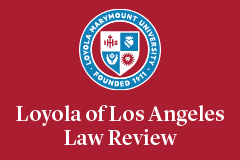Abstract
During a fairly routine traffic stop of a motorist driving a rental car, two State Troopers in Harrisburg, Pennsylvania, discovered that the driver, Terrence Byrd, was not the listed renter. The Court ruled that Byrd nonetheless retained a Fourth Amendment right to object to the search. The Court did not address, however, why the Troopers stopped Byrd in the first place. A close examination of the case filings reveal suggests that Byrd was stopped on the basis of his race. The racial feature ofthe stop is obscured by the Court’s current property-basedinterpretation of the Fourth Amendment’s right to privacy.
Although the property-based approach is supposed to be an improvement upon the privacy approach, it merely repeats the problems of incoherence or judicial fiat that undermine theprivacy regime it is supposed to replace. The Court’s newproperty analysis turns upon traditional property notions of possession, control, and the right to exclude. However, property concepts are not neutral in the manner that the Court envisages. For example, it is not clear that property, rather than tort or agency or even criminal law, is uniquely applicable to determine the outcome of any given dispute, so that where there are multiple eligible options, then the judge can pick the one that best suits her own preference. Furthermore, even within property law, there are different ways in which property concepts may be used to interpret the Fourth Amendment right to privacy, and so the Justices can and do select among a palate of conflicting property options.
We can contrast the property-based approach with ChiefJustice Roberts’s anti-arbitrariness approach to the Fourth Amendment jurisprudence in two recent Big Data cases, Riley v. California and Carpenter v. United States. In these cases, the Chief Justice repeatedly insists, firstly, that the Fourth Amendment was adopted in response to an institutionalized, state policy targeting the public for mass searches of their homes and persons; and secondly, that technology has transformed personhood in ways that make persons more dependent and insecure. This transformation has made us, not independent, but increasingly dependent and vulnerable, so that we are liable to government searches that go beyond physical limits that would otherwise constrain the scope of the search.
The Chief Justice’s anti-arbitrariness jurisprudence rejecting unwarranted mass searches of vulnerable persons applies more generally, outside the realm of big data, to other ways in which persons are vulnerable and dependent. For example, his approach also applies to the type of institutionalized drug interdiction of automobiles discernible in the Byrd case, which raises the specter of mass policing of racial minorities. This mass policing of people of color renders the personhood of minority car divers dependent and vulnerable in similar ways to mobile phone users. Accordingly, a better option would be to develop Chief Justice Roberts’s personhood analysis to take into account ways in which racially targeted mass policing transform personhood in ways that make them dependent and insecure.
Recommended Citation
Eric J. Miller, Property, Persons, and Institutionalized Police Interdiction in Byrd v. United States, 52 Loy. L.A. L. Rev. 107 (2018).
Included in
Civil Rights and Discrimination Commons, Constitutional Law Commons, Criminal Law Commons, Criminal Procedure Commons, Fourth Amendment Commons, Law and Race Commons, Supreme Court of the United States Commons


